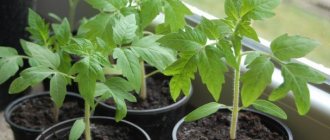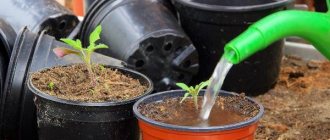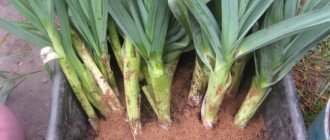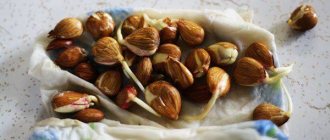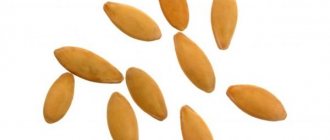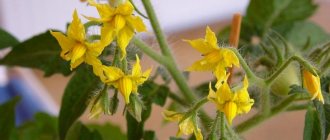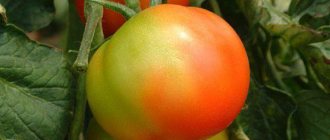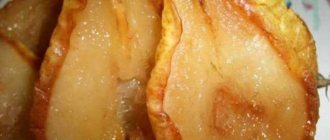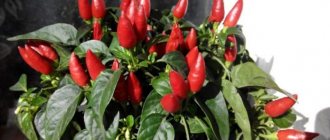Description and characteristics of the variety
The Cyfomandra tomato variety is named after a unique plant from South America called the “tomato tree.” It is suitable for cultivation in different regions of Russia in open ground, a greenhouse or under film cover, depending on climatic conditions.
- The plant is indeterminate and grows to a height of about 1-1.5 meters.
- A standard type bush, with a strong trunk and moderate branching.
- It is recommended to grow in 1-2 stems.
- The leaves are unlike tomato leaves; they are large, elongated, and resemble an elongated heart.
- Late ripening period. Tomatoes will ripen 120-150 days after germination.
- Up to 6-8 tomatoes are formed on one brush, which are larger at the bottom and become smaller at the top.
- Productivity is high, up to 6 kg per bush. From 1 sq. m harvest about 20 kg of ripe tomatoes.
- Extended fruiting period; in closed ground, bushes can bear fruit for 7 months.
Tomato Tsifomandra: description of the variety
| Variety name | Digitomandra |
| general description | Late-ripening, medium-growing and productive variety of bush tomatoes for growing in greenhouses and open ground. |
| Originator | The plant is native to South America. In our conditions, Cyphomandra of a different genus is grown. |
| Ripening period | 120-150 days |
| Form | The fruits are heart-shaped. |
| Color | The color of ripe fruits is pink-raspberry. |
| Average weight of tomatoes | 150-300 grams |
| Application | Good for fresh consumption, for making sauces and juice. |
| Productivity of the variety | up to 20 kg and 1 sq.m. |
| Features of cultivation | Sowing 60-65 days before planting. 4 plants per 1 square meter. |
| Disease resistance | Resistant to most diseases. |
Cyphomandra is a unique variety that has rightfully earned the name “tomato tree.”
The plant is indeterminate, standard type, with a strong trunk and moderate branching. The leaves are dark green and medium in size. The fruits ripen in large clusters of 6-8 pieces. The tomatoes on the lower branches are larger. The yield is excellent, from 1 sq. m of plantings, you can collect up to 20 kg of selected tomatoes . The fruiting period is extended; in closed ground it can last up to 7 months.
You can compare the yield of Cyfomandra with other varieties in the table below:
| Variety name | Productivity |
| Digitomandra | up to 20 kg per square meter |
| Kate | 15 kg per square meter |
| Crystal | 9.5-12 kg per square meter |
| Red Arrow | 27 kg per bush |
| Verlioka | 5 kg per bush |
| Explosion | 3 kg per square meter |
| Caspar | 10 kg per square meter |
| Raspberry ringing | 18 kg per square meter |
| Golden heart | 7 kg per square meter |
| The Golden Fleece | 8-9 kg per square meter |
| Yamal | 9-17 kg per square meter |
Read about other high-yielding and disease-resistant varieties here.
The fruits are large, weighing up to 200 g. The shape is flat-round, with slight ribbing at the stalk. The pulp is dense, fleshy, the number of seed chambers is at least 6. The skin is not hard, well protecting the fruits from cracking. High sugar content (about 2.3%). The taste is very pleasant, sweetish, tomatoes have a delicate, recognizable aroma .
Below you can see information about the weight of fruits of other tomato varieties:
| Variety name | Fruit weight (grams) |
| Digitomandra | up to 200 |
| Diva | 120 |
| Red Guard | 230 |
| Pink spam | 160-300 |
| Irina | 120 |
| Golden Jubilee | 150-200 |
| Verlioka plus f1 | 100-130 |
| Dad | 250-400 |
| Countryman | 60-80 |
| Shuttle | 50-60 |
| Dubrava | 60-105 |
Fruit characteristics
- Large-fruited.
- The average weight of one tomato is up to 200 g.
- The shape is round, slightly flattened, with slight ribbing in the area of the stalk.
- The color of ripe tomatoes is pink-raspberry.
- The pulp is dense, fleshy.
- Inside there are 6 or more seed chambers with an average number of seeds.
- The skin is dense but tender.
- Tomatoes do not crack.
- Sugar content is approximately 2.3%.
- The taste is sweetish, the aroma is delicate, unique to this variety.
- They have good keeping quality.
- Ripens perfectly outside the bush at room temperature, maintaining appearance and taste.
Diseases and pests
Growing an exotic plant can be marred by pests that also attack ordinary tomatoes:
- Thrips.
- Aphid.
- Whitefly.
- Spider mite.
It is worth fighting them when the first signs appear. At the initial stage, you can get by with a soap-ash solution. In advanced forms, when pests have formed large colonies, insecticides will have to be used.
If soil contaminated with fungus is used, fungal disease may occur. Prevention saves:
- Disinfection of soil before planting (potassium permanganate, fungicidal drug).
- Loosening the soil and using mulch.
- Maintaining the required temperature and soil moisture.
- Regular application of fertilizers.
It is worth fighting them when the first signs appear. At the initial stage, you can get by with a soap-ash solution. In advanced forms, when pests have formed large colonies, insecticides will have to be used.
Photo
The photo shows tomatoes of the Cypho Mandra variety.
How does such a plant reproduce?
What is a Cyphomandra tomato? The description of the plant should begin with its trunk. This part of the tree develops quite quickly. Gradually, rapidly lignifying and branching trunks are formed. The leaves have an oval shape. They can be approximately 20 centimeters in length. At the same time, the edges of the sheets are smooth and without islands.
Judging by numerous reviews, the Cyfomandra tomato bears fruit well. Tomatoes taste similar to ordinary varieties that are often grown in our country. The fruits themselves are round in shape. Up to 8 tomatoes can form on one brush. They are usually slightly elongated and small in size. As for the seeds, they are larger and flattened than those of traditional varieties.
Cyfomandra tomatoes, the photo of which is presented above, are most often propagated by seeds. However, there is another way - vegetative. It is carried out using cuttings. To propagate plants using this method, the following sequence should be followed:
- A young branch should be cut from a fruitful, strong tree. It must have at least three buds.
- Fill a liter jar with clean water and place a twig in it. The planting material should be regularly inspected for characteristic swelling below. This will indicate the beginning of the formation of the root system.
- When swelling appears, the jar must be covered with polyethylene and placed in a place where it is warm and away from sunlight.
- When roots begin to form, it is necessary to transplant the cutting into the soil.
We suggest you familiarize yourself with: Salted pumpkin pancakes
As noted in the reviews, such a plant propagates not only by seeds and seedlings, but also by cuttings. Using this method, you can get plants that look more like bushes.
Advantages and disadvantages
The main advantages of the variety include the following:
- Excellent taste.
- Long-term fruiting.
- They can be stored for a long time after collection.
- Easy to care for.
- High yield.
- Resistant to temperature changes.
- Good immunity against nightshade diseases.
There are not many disadvantages of the Tsifomandra variety, and even those listed below are insignificant.
- A garter to the support is required.
- It is necessary to apply fertilizing.
How to grow from seeds
How does Cyphomandra reproduce? Tomato, which has positive reviews, can be grown from seeds. This is the most reliable way. Especially if the planting material was purchased from a trusted place. The growing process itself is carried out in several stages:
- Before planting, the seeds of the plant should be washed in a weak solution of potassium permanganate and water. After this, experts recommend drying the planting material at room temperature and only in the shade.
- To speed up the germination process, seeds should be placed for 24 hours in a place where the temperature will be maintained at a fairly low temperature. One of the shelves in the refrigerator is ideal for this.
- While the planting material is being prepared, it is worth mixing the soil. A mixture of river sand and peat is ideal for this type of tomato. The soil should be light and airy.
- Tomato seeds are sown in rows, with a gap of at least 60 centimeters between them. It is also recommended to leave space between planting materials. In this case, the distance between the seeds should be at least 30 centimeters.
- The seedlings should be transplanted into open ground at the end of May. These tomatoes also grow well in greenhouses.
Features of cultivation
Seeds of the Tsifomandra tomato variety are produced by many originators, including the Siberian Garden .
Tomatoes can be grown in seedlings and also propagated by cuttings. Sowing of seedlings is carried out 60-65 days before planting in the ground. The seeds are first disinfected in a light solution of potassium permanganate, washed under water and dried.
The soil for planting should be light. It is better to make a mixture of equal amounts of garden soil and peat, to which a little washed river sand is added. The seeds are lightly buried in the soil, sprayed and left in a warm place for germination. To speed up this process, you can first keep the seeds in a growth stimulator, for example, Zircon.
When the first 2-3 true leaves are formed on the seedlings, they are picked into separate pots.
Advice! If the seeds are immediately sown in separate peat pots, picking will not be required.
The seedlings are transferred to open ground, a greenhouse or flowerpots after May 15, depending on field conditions. By this time, the seedlings will get stronger and up to 7 true leaves and the first flower clusters will form on them.
The soil for filling the holes is mixed with humus.
Seedlings are planted at intervals of 50 cm. Scheme: 3-4 plants per 1 sq.m.
If seedlings are transplanted into pots, drainage holes must be made in their bottom and placed on pallets.
Tall plants are tied to supports. The lateral stepsons are pinched, leaving a stump of 5-7 mm, so as not to damage the main stem. They can be used for rooting.
More information about growing tomatoes is described in the article: Technology of growing tomatoes. Secrets of planting and care
You might be interested in: How to properly plant tomatoes in a greenhouse: bush formation diagram, care features, photos and videos
Useful information: How to properly tie tomatoes in open ground: the best methods, step-by-step photo and video instructions
Tomato tree – South American exotic
Cyphomandra, or tamarillo, grows and bears fruit for 3 years. This beautiful plant is covered with pubescent leaves (20 cm long), emitting a light, specific aroma. The flowers are fragrant, pale pink or lavender in color. The diameter of the flower is up to 2 cm. The value is tomatoes, or rather the fruits that resemble them. They are up to 10 cm long, smooth, regular ovoid in shape, and weigh about 200 g.
The seeds may be dark, almost black. They have a bitter taste, so they are peeled during cooking. The orange-red or yellow flesh can be used in dishes like regular tomatoes. The skin is a bit tough, so it is usually removed. It can be easily removed.
Tomato trees require a high room; they can reach a height of 2.5 meters. When providing the plant with 10-12 hours of daylight, up to 20 kg of useful fruits are collected from the tree. This is a good yield.
Cyphomandra, or tamarillo, grows and bears fruit for 3 years. This beautiful plant is covered with pubescent leaves (20 cm long), emitting a light, specific aroma. The flowers are fragrant, pale pink or lavender in color. The diameter of the flower is up to 2 cm. The value is tomatoes, or rather the fruits that resemble them. They are up to 10 cm long, smooth, regular ovoid in shape, and weigh about 200 g.
The seeds may be dark, almost black. They have a bitter taste, so they are peeled during cooking. The orange-red or yellow flesh can be used in dishes like regular tomatoes. The skin is a bit tough, so it is usually removed. It can be easily removed.
At the moment, there are several types of this variety, each of which has certain characteristics. The most common variety of Cyphomandra tomatoes is Cyphomandra beetroot. This extraordinary plant belongs to the nightshade family. As a rule, this variety of tomatoes is grown not only in greenhouses. The evergreen tree can be planted in pots. In summer, it is recommended to place the plant outside, as it needs sunlight.
Reviews from vegetable growers indicate that Cyfomandra tomatoes are a healthy delicacy, rich in beneficial micro- and macroelements, as well as vitamins. Therefore, this tomato variety is especially popular among farms. Indeed, in addition to taste, such tomatoes have a high level of productivity with a long fruiting period.
Many in their reviews recommend buying the Tsifomandra Siberian Garden tomato. These seeds are more adapted to the climate of our country. Thanks to this, the plants will get sick less. It is worth noting that the variety of these tomatoes itself is quite resistant to many common diseases, including fusarium and verticillium. Problems are usually caused by insects. This variety is often attacked by thrips, spider mites, whiteflies or aphids.
We suggest you read: How to make a drain from scrap materials with your own hands
To prevent diseases, experts recommend disinfecting plants and soil before planting. To do this, you can use special solutions that are sold in specialized stores. As for parasite infestations, they can be controlled with the help of industrial insecticides.
Basic care
Judging by the reviews of experts, the tomato variety Tsifomandra is practically unpretentious in care. The main thing is to know all the rules and requirements of plants. This variety first of all needs a sufficiently long daylight hours. This is one of the main conditions. Therefore, experts recommend providing plants with additional lighting at night.
Also, do not forget about feeding. Fertilizers should be applied systematically. In this case, it is necessary to use fertilizers that contain phosphorus and potassium. As for watering, it should be moderate. Judging by the reviews, tomatoes need periodic spraying. You can use a spray bottle for this. If the leaves begin to turn yellow, they should be removed. It is also worth periodically carrying out pinching.
Tags: description, variety, tomato, characteristics, tsifomandra
About the author: admin4ik
« Previous entry
Tree care rules
The rules for caring for the Cyfomandra tomato variety include standard procedures: timely watering, application of fertilizer mixtures, removal of weeds, pinching and preventive measures to prevent diseases.
Watering and air humidity
To achieve uniform ripening of large tomatoes, weekly watering is essential. To do this, bring a bucket of water under each bush, being careful not to get it on the green part of the plant. The first irrigation is carried out 10 days after planting the seedlings. If you water the plant right away, the root system will begin to rot. If there is insufficient moisture, tomatoes may crack. During drought, mulching should be done: sawdust or peat is added under the plant.
Top dressing and fertilizer composition
Feeding is done every two weeks. The first application of fertilizers is carried out two weeks after planting the seedlings. First of all, mullein infusion or a special mineral fertilizer is applied, and during the ripening of the fruits, only ash solutions are applied. The second time, replenishment is carried out when brushes are formed. During this period, potassium, copper sulfate, Dissolved or Chamber are used. To enhance the growth of tomatoes, it is recommended to use a solution of boric acid.
Pruning and shaping the Digital Mandarin
Due to its strong growth, the bush must be tied up as the fruits ripen. In some cases, it may be necessary to install individual supports. The plant is formed into two stems, and must also be tied to a support. In regions with short summers, all shoots are removed so that the tomatoes have time to ripen on the vine. Pinching the crown is carried out if necessary - if during ripening the bush continues to grow and new flowers appear. In addition, all weak, yellowed and wilted leaves should be removed once a week. Pruning is carried out when the sprouts have reached 5 cm in length.
